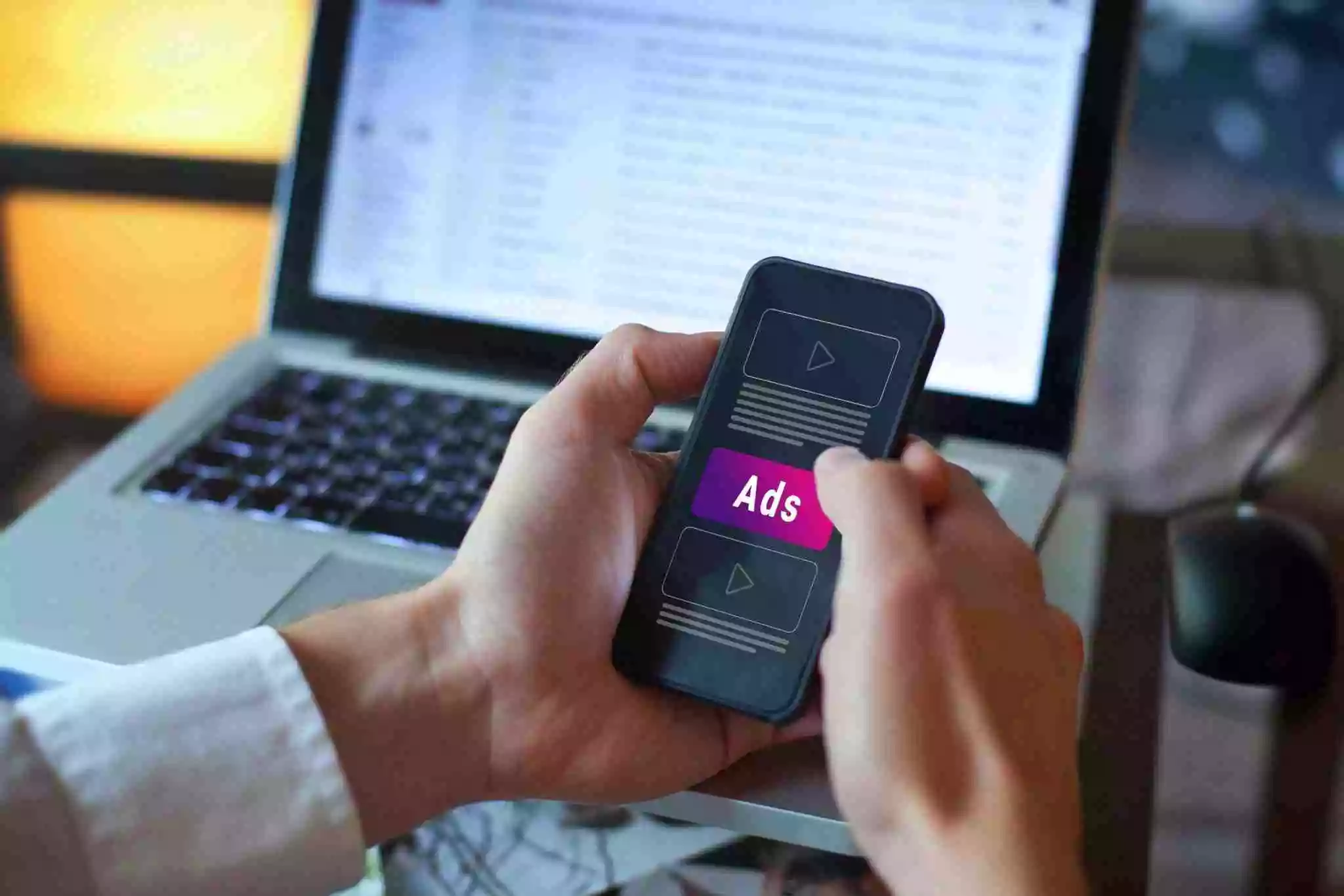What are the right mobile ad formats and the best mobile ad sizes? The question never gets old, and publishers are still searching for the right answer.
Well, to put an end to this curiosity, we curated this ultimate guide.
From best-performing mobile ad sizes to IAB’s rising mobile ad units, you’ll learn everything to double your mobile ad revenue.
According to Statista, US advertisers will spend $400 billion on mobile advertising in 2024, a 17.2% increase from the previous year. Another interesting piece of data compiled shows that 55% of the website traffic originated from mobile devices, and 92.3% of internet users use mobile devices to access the internet.
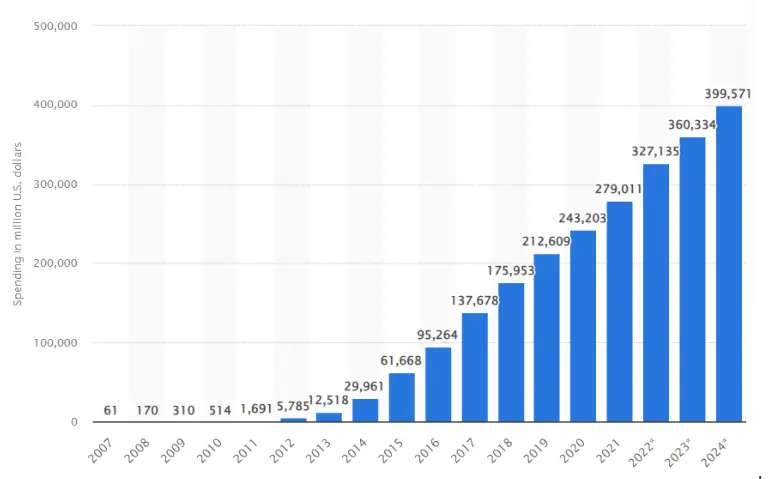
Hence, it is obvious that both users and advertisers are getting into mobile every year. And they aren’t going to slow down. As a publisher, do you know where the focus should be?
Mobile ad revenues.
According to the IAB revenue report, Mobile ad revenue is increasing more YoY than the desktop. This statistic means that brand marketers are open to putting ads on your site only if you have the right formats and ad sizes in place.

Besides, ensuring the right ad sizes/formats increases your CPMs, viewability, and engagement rates. So, in this guide, we’ll explore the right mobile ad formats and standard mobile ad sizes and learn how to pick the right ones for your site.
Table of Contents
Best Mobile Ad Formats and Ad Sizes
With everyone creating their own rich-media mobile ad formats, it is easy to get overwhelmed and confused. But as a publisher, do you really need to display all the fancy ad formats to your users?
Ask questions and make sure there is a rising demand for the format. Else, you would be sacrificing the user experience for nothing. Let’s start with the standard ad formats and ad sizes that have buyers all around the globe.
Mobile banner ads
Standard mobile banner ads are the most popular and widely used format for monetizing mobile traffic. Both publishers and advertisers flock towards the banner ads as soon as they’re into mobile advertising. That being said, you can expect to face some hiccups from ad fraudsters while running IAB banner ad units.
Why should you try it?
– Always in demand.
– Easy to implement and optimize.
– Non-intrusive to readers.
– Can yield better CPMs with the right ad placements.
Mobile banner sizes
When it comes to mobile banners, you can bet on three ad unit sizes – 300*250, 320*50, and 300*50.
300*250, also known as ‘medium rectangle, ‘ has been proven to help publishers. Google included the ad unit size in its “Top Performing Ad Sizes” list. At first, Google’s ad policy restricted the publishers from placing the 300*250 unit above the fold. But now, you can do so. Advertisers would be willing to pay more as users would see the ad as soon as they opened the webpage.
- Most Popular Display Banner Ad Sizes
We stick to the ad banners mentioned above. But if you want to see other options, you can refer to the most common display ad banners.
Obviously, common ad sizes will have greater demands, thereby getting you the best fill rate and eCPM. As suggested by Google, here are the most common mobile ad banners.
- 300 x 250 – Inline rectangle
- 320 x 50 – Mobile leaderboard
- 320 x 100 – Large mobile banner
- 250 x 250 – Square banner
- 200 x 200 – Small square banner
However, you need to be wary of the ad placement. We advise you to follow Google’s recommendation.
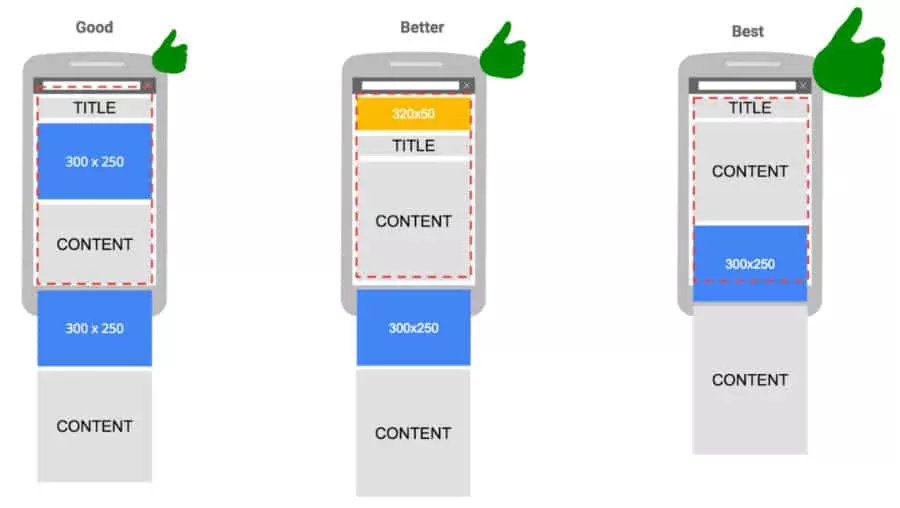
All three standard mobile banners generate better Click-Through Rates and Engagement Rates.
Is the banner ad right for you?
To be frank, mobile banners are one of the best options available for mid-market and premium publishers. You can claim an eCPM of up to $100+ with the right placement and audience engagement rate. These are especially proven to help publishers who are looking to add more ad units or are just beginning to monetize.
Mobile video ads
They are one of the fastest-growing ad formats in the industry. As users watch more video content daily, advertisers have already started pouring their marketing budget into video ads. Besides, video ads can tell a story, and brand recall is way higher than banner ads.
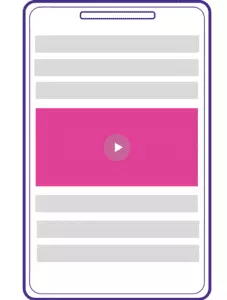
Why should you try it?
– Fastest growing ad format
– Yields the highest CPMs for publishers
– Better user experience
– Grabs the attention of the users
Mobile video ad sizes
When it comes to mobile video ads, you can rely on – 320*480 and 480*320. Besides, you can run out-stream video ads in 300*250 units. They all can generate higher CPMs and Video Completion Rates (VCRs).
Is the Video Ad right for you?
Before running video ads, you need to decide on the type. Is it going to be outstream or third-party video distribution (Instream)? Either way, you need to have a stellar page load time and optimization technology in place. Also, Knowing about the best video players for publishers will be helpful.
Mobile interstitial ads
Mobile interstitial ads are the visuals that pop up when users try to close/switch the webpage. They offer engaging content and a call to action, covering the complete mobile screen. These ads are more common in gaming apps and websites, requiring users to interact often.
You can try the full-screen size or opt-in for other standard sizes. When it comes to demand, advertisers with the goal of conversion (not brand awareness) are increasingly experimenting with the interstitial format.

Why should you use it?
– Can give higher CPMs as the viewability is at 100%
– Higher demand among the advertisers
– Easily to implement
– Increased CTR than banner ads.
– User-triggered
Mobile interstitial ad sizes
Interstitial ads can perform well when you use 320*480, 320*50, and 300*50.
The most popular interstitial ad size is 320*480. However, it captures the full screen of the mobile and stalls the user. So, you should use them sparingly.
Be cautious while using pop-ups, as Google can block the ads on your sites if you do not follow the Better Ads Standards. To ensure you are not violating the standards, learn how to use Google Ad Experience Report.
Is that right for you?
If you’re willing to try interstitial ads, you must primarily consider Users and page load time. If the users prefer to stay on the site rather than bounce off, you may need to try other formats.
Because interstitial ads usually cover the screen and ask the user to close or click it. If your average page views are over 3, then you’re driving users away with the ad.
When the page load time exceeds the acceptable value, you can’t run interstitial ads, as they can make the page even slower.
Mobile native ads
Mobile native ads are the ones that blend well with the content on your site. They are non-intrusive and the most subtle form of advertising. However, they are proven to earn higher views and shares than the other ad content formats.
Users will often engage with the content without realizing it is an ad. If the ads match the page’s context, the CTRs can go as high as 50%.
Why should you try it?
– Best option to monetize without hampering the user experience.
– Growing demand.
– Better ad viewability and engagement rates.
Mobile native ad sizes
When it comes to native ads on mobile, you can try 320*480. However, you can run different ad unit sizes that are native to your content. But accessing the demand will be harder that way.
Is that right for you?
Any publisher with a highly engaging audience can yield higher CPMs with native ads. Though they can be left unnoticed, relevant ads can gather more views and conversions for advertisers. So, if you have a targeted niche or first-party data to supplement the campaign, you can go with this format.
Read our detailed guide on how to set up and implement native ads with Google Ad Manager.
Rich media ads
Rich Media Ads are ads with rich formats such as videos, GIFs, and audio. Users can interact or even complete the intended action without leaving the webpage. Publishers generally serve rich media ads by combining display and interstitial ads.
Though the format is popular among app publishers, rich media formats such as Expandable ads are also used on the mobile web. They offer a better ground for advertisers to completely showcase their service/product.
According to a study by the IAB and comScore, rich media ads result in 79% higher user engagement, an 18% increase in brand recall, and a 23% increase in message recall. In addition, 43% of the respondents said that rich media ads grab their attention better than banner ads. However, keeping the number of ads minimal is essential to prevent bounces and user frustration.

Why should you try it?
– Higher CPMs/CPAs than the other ad formats (excluding video ads).
– Overcomes banner blindness.
– Performs well with the right context.
Rich media ad sizes
Expandable ads with 320*480 are considered the best option.
Is that right for you?
If you have the right team to optimize and approve the ads constantly, then you can give it a try. Besides, you must partner with the right ad tech vendor to ensure they can properly handle and deliver rich media ads.
Of all, ensure your users stay longer than at least 2 minutes before exploring the format.
Consolidated Table of Suitable Mobile Ad Formats and Sizes
|
Mobile ad formats |
Mobile ad Sizes |
|
Mobile banner ads |
300*250 320*50 320*100 300*50. 300*100 |
|
Mobile interstitial ads |
320*480 480*320 300*400 300*250 320*50 300*50 |
|
Mobile video ads |
320*480 320*180 (instream video ads) 480*320 300*250 (outstream video ads) |
|
Mobile native ads |
320*480 |
|
Rich media ads |
320*480 (expandable ads) |
Mobile Rising Stars Ad Units
IAB released the rising ad units, which can be a “canvas for the next generation of mobile advertising.” As they are new to mobile advertising, few ad exchanges offer the format, and the demand is pretty low. However, they will be attracting more publishers and advertisers shortly. So, we included it here to let you keep an eye on them:
FilmStrip
The mobile filmstrip is a 320*250 rich media ad unit that expands to a full screen and allows the advertiser to tell a story. A user can slide five different media in a single banner. Publishers, including Business Insider, Gizmodo, and Lifehacker, are actively using the ad type.
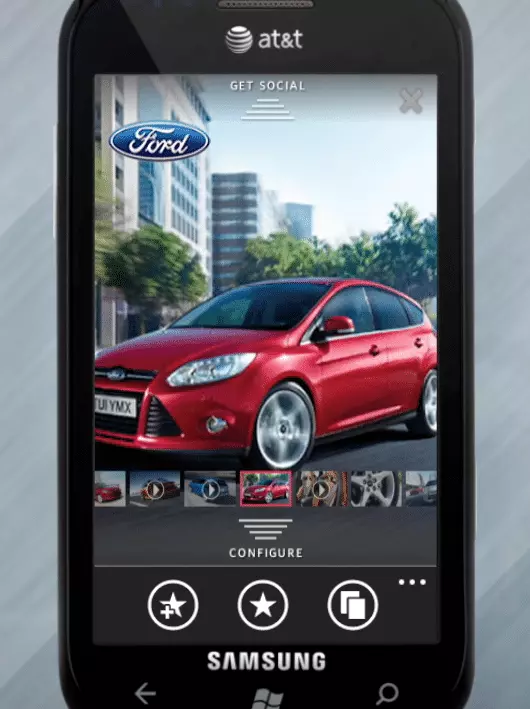
Image Source – IAB
Adhesion banner
Adhesion banners are the tenacious ad units at the top or bottom of the mobile screen, which can be expanded to the full screen upon user action.

Image Source – IAB
Slider
Mobile sliders are also tenacious ad units that stay at the bottom of the screen. It doesn’t obstruct the user in any way. Once slid, the user can see the complete ad with the call to action.
With the sizes of mobile ads being too small, ad units utilize user-initiation to take the full screen, thus ensuring the brand message is delivered clearly and conveniently.
Mobile Ad Formats that Generate More Revenue
According to IAB’s latest ad revenue report, Display ads have the largest ad revenue share of 30%, which is $63.5 billion. Display ads include banner ads, rich media ads, sponsorship, etc.
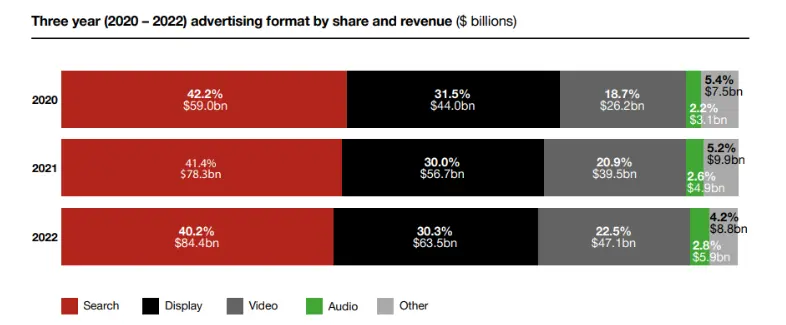
This data gives the revenue of ads from both desktop and mobile. Considering the data that 75% of internet advertising revenue has come from mobile ads, we can infer that mobile banner ads (display ads) stay second in higher revenue-generating ad formats.
Followed by display ads, video ads have generated higher revenue with a share of 22.5%, amounting to $47 billion. Overall mobile banner ads and video ads proved to be the higher revenue-generating mobile ad formats.
Popular Mobile Banner Ad Sizes
The popularity of ad sizes changes from time to time depending on user preference, engagement rate, and screen size at a particular time. No matter how many ad formats come, banner ads stayed at the top for years. Currently, the following mobile ad sizes are popular with higher engagement rates.
300*250: medium rectangle
A smaller ad unit that perfectly fits on mobile devices and doesn’t take up too much of the webpage’s space. This medium rectangle unit gives optimal results when embedded between the content or at the end of the content. It accepts image and text formats.
320*100: large mobile banner
Large mobile banner is the top performing AdSense size and the big brother of the sizes 320*50 and 300*50 ad units. This size fits with most dimensions of ad slots on the website. It is suitable for the website with most of the traffic from mobile.
320*50: mobile leaderboard
This slightly bigger ad format is highly suitable for mobile. The cost of this ad size is less than other bigger ad units. It accepts images and text ad formats, and publishers can show these ads on top or bottom of the page. It can be intrusive, so the leaderboard must have a close button.
320*480: expandable ads
Expandable ads are rich media ads like filmstrip and adhesion banners (as discussed before) that expand to a larger screen after the user initiation. The size of expandable ads is less intrusive, and it has become more popular recently with user-friendly features.
Best Size and Format-Bigger Revenue
As we always say, there’s no one-size-fits-all solution in adtech. You should have a data-driven approach. You should explore, experiment, and then settle on the right ad formats and sizes that yield higher CPMs and enhance the user experience.
Whether you use display ad networks or programmatic sellers, this piece will be handy. We’ve listed all the best mobile ad sizes and formats in 2024. It’s up to you to pick the suitable ones and ignore the rest. Let us know how it goes in the comments.


